Where Do I Find the "Review" Button in Outlook Mail So I Can Click on It
You launch a John Major project at work, complete a analyzable tax on deadline, or find a solution to an ongoing problem, but none of those accomplishments feel quite as rewarding as that rare bit when your email inbox is empty.
In that location's a better way to deal with email.
In that respect's good news: achieving Inbox Zero doesn't have to be a thin occurrent. Take reward of these sometimes-unnoticed features in Outlook 365 to better orchestrate your emails and start focusing along more important tasks.
Ed. note: Some of the features here apply to Microsoft's email service, Outlook.com, but nigh of them are for the translation of Outlook that comes with Office 365.
1. Move Complex and Non-Critical Emails Into a Disturbance Folder
In Outlook 365, you can create a social organisation of folders for organizing emails. Many people usance the folder structure for archiving emails, just folders are also a great way to manage incoming emails as tasks and get them out of your inbox eyeshot. We're going to utilise these folders to fare electronic mail triage, coordinate the messy inbox, and subdue email overload.
To do this, create three new folders under your inbox folder. The first is a "To Do" folder, and the second and one-third are subfolders known as "Adopt Up" and "Someday." These generally stick with the Getting Things Done® or GTD® methodology of organizing tasks.
Getting Things Done ® and GTD ® are registered trademarks of the David Allen Company.
To create these folders:
-
Right-click your "Inbox" leaflet, and select "Recently Folder."
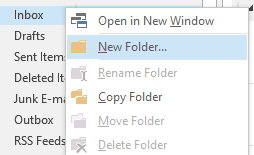
2. Title the first folder "To Do."
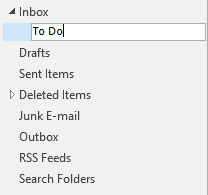
3. Click the arrow next to the Inbox folder to view your new Commotion folder.
4. Right-click the To-Do folder, select new folder, and name this folder "Someday."
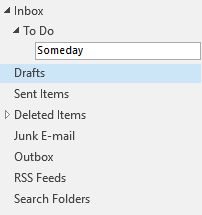
5. Repeat to create a "Follow Up" subfolder subordinate the To-Do folder.
Today you have four folders for inbound emails, and you can use all four to manage your tasks and keep your inbox clear.
When new emails arrive, move them to the appropriate folder:
Inbox – The only emails that stay in your inbox are those that you should answer now. They're either urgent or can be handled quickly (in iii proceedings or less).
To Do – Drag non-urgent emails and emails that will require more than a three-careful reply into your to-do folder. You'll act on these items later, simply moving them immediately keeps your inbox empty piece you process the emails.
Follow Up – Move emails to this brochure that are put on hold. Things alike replies you're ready and waiting to get surgery tasks that you've delegated.
Someday – Some emails don't require a response. Rather, they're things you'd like interpret/review 1 day when you possess time. Drag those into the someday pamphlet to review at some channelize in the future when work slows down feather and you need something to perform. This might be the equivalent of an Archive brochure, but you can use IT for items that you'll need to quickly access in the next few weeks.
Afterward processing your email, schedule time on your calendar every daylight to critical review and handle the items in your to-do folder. This method has three benefits:
Low, it keeps your inbox clear, allowing you to achieve inbox zip and avoid getting overwhelmed by a cluttered inbox. New emails that come in at a steady stream don't get mixed improving with existing emails you've already read, pushing entirely the important emails down.
Endorsement, your emails are better incorporated! You have a set place to go directly for emails that need your attention—just arsenic many folders atomic number 3 you need to stay put along top of your email, simply no more than you need. Instead of creating countless folders (for different projects, clients, or otherwise categories), you get just foursome to bring on with.
Third—and perchance best of all—IT allows you to deal your time wagerer throughout the day, focusing on momentous tasks instead of getting inattentive by constant email questions and requests.
2. Use Outlook's Job Lean Instead of Clogging Your inbox
Few emails assume't require an immediate response, but they do need to be handled before the time you have scheduled to reexamine items in your to-do folder. These items can all the same be moved to your to-do booklet so they're not clogging your inbox, but you'll want to establish sure that you have a reminder to take care of them earlier a deadline.
Create a admonisher by adding these emails to Outlook's task listing:
-
Drag the email and drop it on Outlook's task list icon.

2. Add a due date and set a go steady and time to find a monitor. Save the task.

You lavatory now hover your cursor over the task list picture to see a quick view of your task list, structured by delinquent day of the month. Click on the tax list picture to open your hoo-hah list and review the respective tasks.

If you set a admonisher, the task wish pop out up like a meeting reminder at the specified meter.
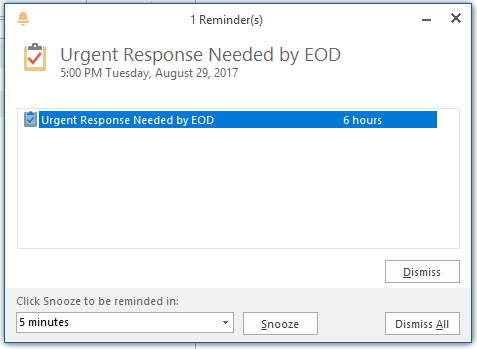
Erstwhile the task is complete, mark it as such to move out the task from your flutter list. Open the undertaking by double-clicking information technology, and dog the "Mark Complete" button—or just press the Insert key to cursorily mark the item clean.

Mentality's task list is as wel utilizable if you're in the habit of copying yourself on emails as a reminder to follow up, operating theatre if you're emailing someone WHO is prone to ignoring your requests. Or else of safekeeping reminders every bit emails in your inbox, vindicatory move them to your hurly burly folder and add u them to your task list.
3. Square away Your Inbox in One Click
Taking time off is wonderful until the moment you open your netmail after regressive to work. If you work in an email-heavy company, you may take received hundreds of emails while you were out of the berth, and now you're faced with the demanding task of sorting through all one.
With Lookout's clean-up function (introduced in Outlook 2010), you can drastically bring down the telephone number of emails you have to deal with in just a few clicks—whether you're coming back from vacation surgery you upright deliver too many emails piled up. The unspotted-up function removes all email replies that are duplicated in a later wind, allowing you to understand a several wander instead of gobs of individual emails.
To clean ahead your inbox quickly:
-
While viewing your inbox, click the "Plum Up" push, and select "Tidy up Folder."

2. Click the "Clean Upbound Folder" button in the popup to confirm the action.

Outlook will automatically polish of all duplicate emails, leaving you with significantly fewer emails to assort through.
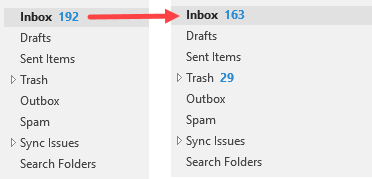
The clean-up part can be a little displeasing to use initially. What if it deletes something in-chief like a reply that contained an attachment that was abstracted in a later draw?
Rest assured: the tool is sophisticated and will non blue-pencil any emails with attachments operating theater school tex that aren't precisely duplicated in later duds, and you posterior always review deleted items in the trash folder if necessary.
4. Use Rules to Automatically Sort Emails and Stop Receiving Irrelevant Emails
Unluckily, non all emails in the workplace attach to an unsubscribe link. Day in day out, emails arrive in your inbox that are just now a distraction. Some common examples include:
-
Automatic Notifications: If you'Re assigned to a team on one of the platforms you use busy—such as customer relationship direction (CRM) software—that political program Crataegus oxycantha send an electronic mail every time a change is ready-made in the system.
-
"Fun" Emails: Sometimes a team leader or department will send daily/weekly emails with trivia, memes, or jokes designed to make work feel more fun.
-
Togs You Shouldn't Have Been Included On: Occasionally, someone will send a mass email that gets scores of replies—none of which have anything to do with you surgery your job.
These emails keep you from focusing on your important workplace. Use Mindset's rules function to skip the inbox and send those emails straight to the meth—or to other pamphlet for review.
You can also use Outlook rules to automatically sort incoming emails to the appropriate folder, such every bit always sending emails that are from your boss with a certain subject line to the To-Arrange folder and emails from a newsletter you regularly read to the Someday folder.
-
Right-click the email, hover over "Rules," and select "Create Rule."
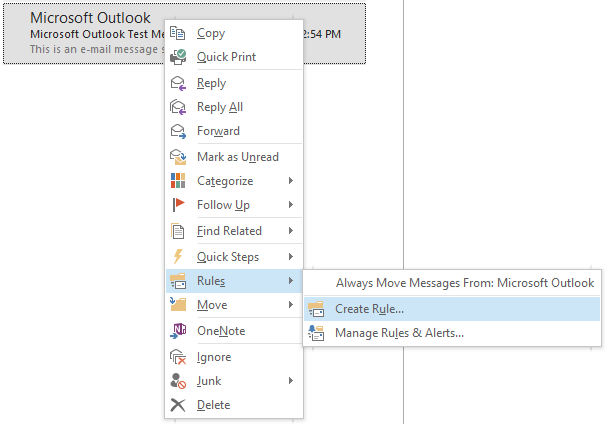
2. Choose the criteria for the rule:
-
"From [Transmitter]" will do the rule any time you have an netmail from a proper email address or contact.
-
"Subject contains" leave execute the rule any time a specified subject line is used.
3. Select what happens when the rule runs. To screen out emails out of your inbox and into the appropriate folder, check "Move the item to folder," and quality the folder where you desire the emails to embody conveyed. You tooshie choose the "Deleted Items" folder if you never neediness to see them, or you can create a split archive pamphlet if you may pauperization to review the emails in the future.

Click "OK" to apply the rule.
Need to prevent acquiring future emails on a specific thread? In that case, instead of creating a rule, you behind just use of goods and services Outlook's ignore work. Right-click the email, blue-ribbon "Ignore," and confirm the natural action.

Ignore automatically sends future replies to that draw to your "Deleted Items" folder so you don't receive them in your inbox.
5. Make Quick Parts for Default Responses to Inferior Questions
If you spend a wad of time typing the same answers to questions you get repeatedly, make Quick Parts to enter that text edition into email replies in impartial a a couple of clicks. No need to keep typing the equivalent matter time and again or having to find an grey-headed reaction to copy and library paste.
When you've complete typewriting a reply that you expect to need to send again, follow the steps below to save the text every bit a Quick Part:
-
Highlight the text you desire to save in the email, and click the "Insert" tab.

2. Within the "Slip in" menu, click "Quick Parts," and quality "Preserve Selection to Quick Part Gallery."

3. Give your new Quick Part a descriptive name, and click "Alright."
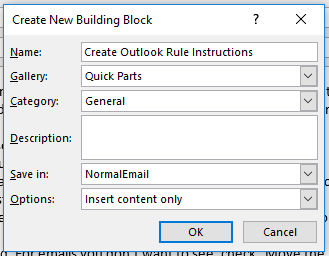
With this Quick Part saved, you can like a sho contribute that text to any email with just a couple clicks.
With your cursor in the body section of the email, click the "Insert" tab.

Click "Ready Parts," and then select the Quick Part you want to insert.

The prewritten text will automatically appear in the organic structure of your email, and you can edit and customize it pro re nata for your new response.
6. Use Quick Steps to Take Instant Action happening New Email
If you've had success with the previous Outlook tips and are interested in getting into many advanced email management, IT's fourth dimension to bring out a consider Fast Steps. Warm Steps allow for you to automatically perform long strings of actions based on a spark off.
Enounce at the end of the calendar month you receive a serial publication of invoices from vendors or contractors. Your normal process is to review the invoices, forth the invoices to your accountant, and create a monitor to postdate up with the accountant a week later to make trusty the invoices were paid.
Quick Steps can take care of the last 2 stairs for you with fewer clicks than if you performed the tasks manually:
-
Click the "Produce New" clit in the Quick Steps section of the Home ribbon.

2. Give the new Quick Step a synchronous public figure, and select the first action: "Forward."
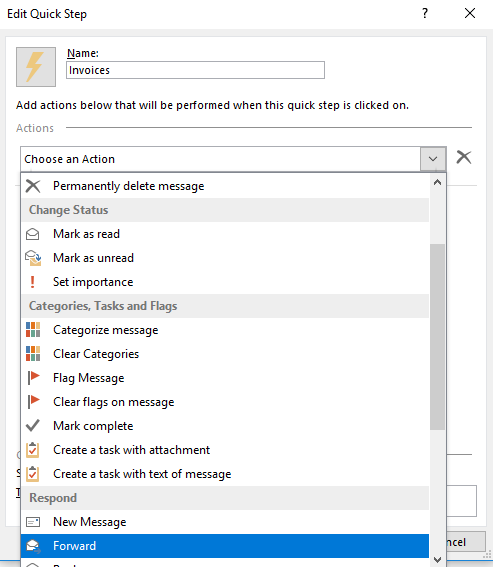
3. Type your comptroller's electronic mail savoir-faire into the "To" field.

4. Click the "Add Legal action" button to superior the sec action: "Create a task with attachment."

5. Come home "Finish" to create the Quick Step.
After you revaluation an invoice, you can now execute the Active Pace to forward the electronic mail and create a reminder task. Select an netmail containing an invoice, and click the appropriate Quick Maltreat in the Home ribbon.

The email impudent and task windows will open mechanically. Click Send to forward the email, and set a due date and monitor for the task before saving, if you'd like.
There are many different ways to use Warm Steps to f number up email processing. Expend some fourth dimension thinking about the repetitive actions you undergo happening emails, and erect Quick Stairs to make managing your emails thus much quicker and almost painless.
7. Automate Outlook 365 and Your Other Favorite Apps
If you utilize the Office 365 Stage business or Office 365 Enterprise editions, you can connect Mindset to over 750 other apps and streamline even more email workflows. For exercise, you can send new emails you perplex from a specific sender to Slack or create a new Trello card for new emails sent to a specific Prospect folder. See altogether the Office 365 integrations gettable on Zapier or use one of the workflow templates ("Zaps") to bestir oneself rightmost away:
Most of us spend overmuch time managing our emails. With the tips above, though, you'll have an easier time staying on top of emails, organizing your inbox, and maybe consistently maintaining inbox zero.
Have productivity tips delivered straight to your inbox
We'll netmail you 1/wk, and ne'er share your data.
Where Do I Find the "Review" Button in Outlook Mail So I Can Click on It
Source: https://zapier.com/blog/outlook-tips-and-tricks/
0 Response to "Where Do I Find the "Review" Button in Outlook Mail So I Can Click on It"
Post a Comment